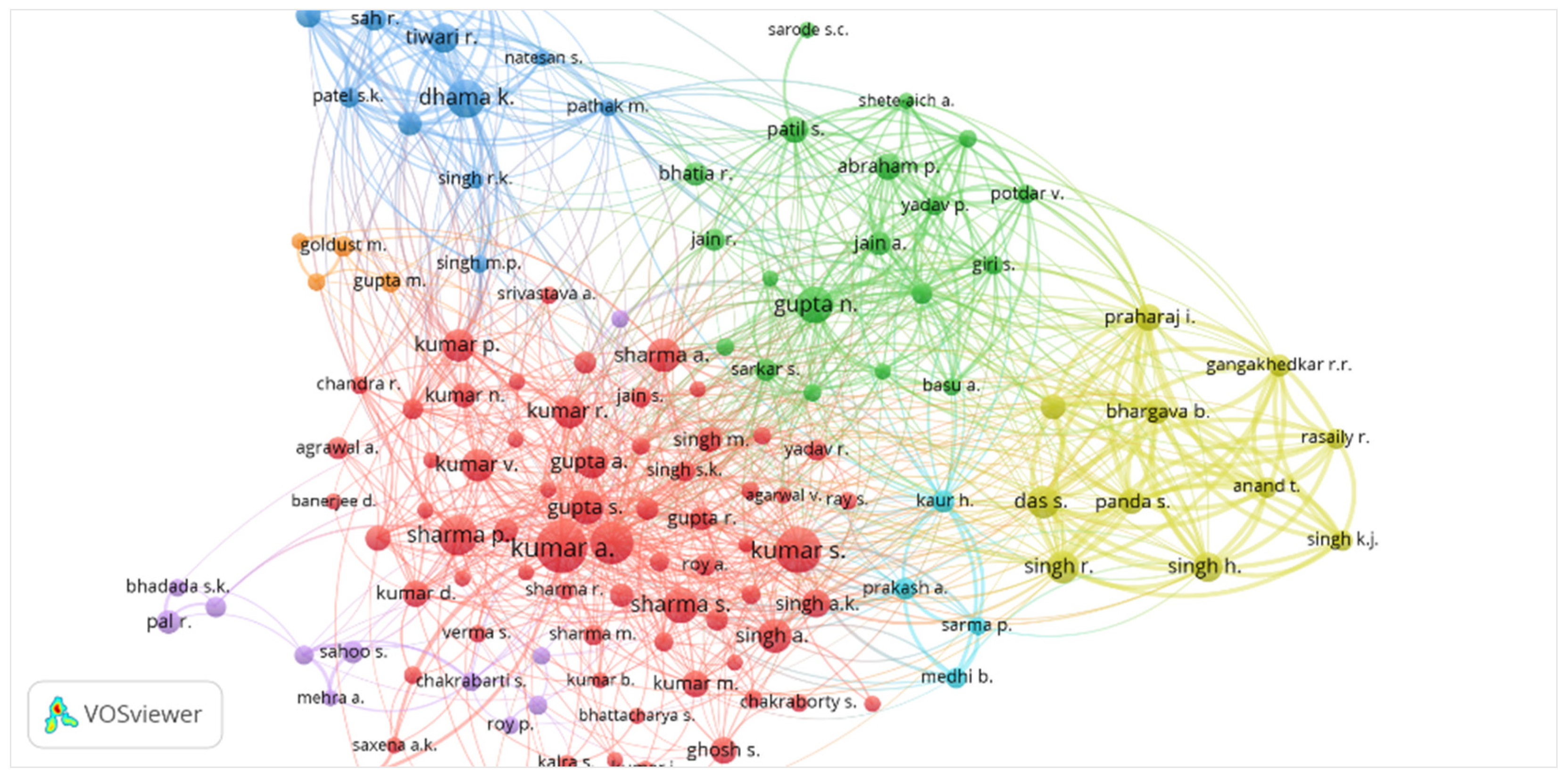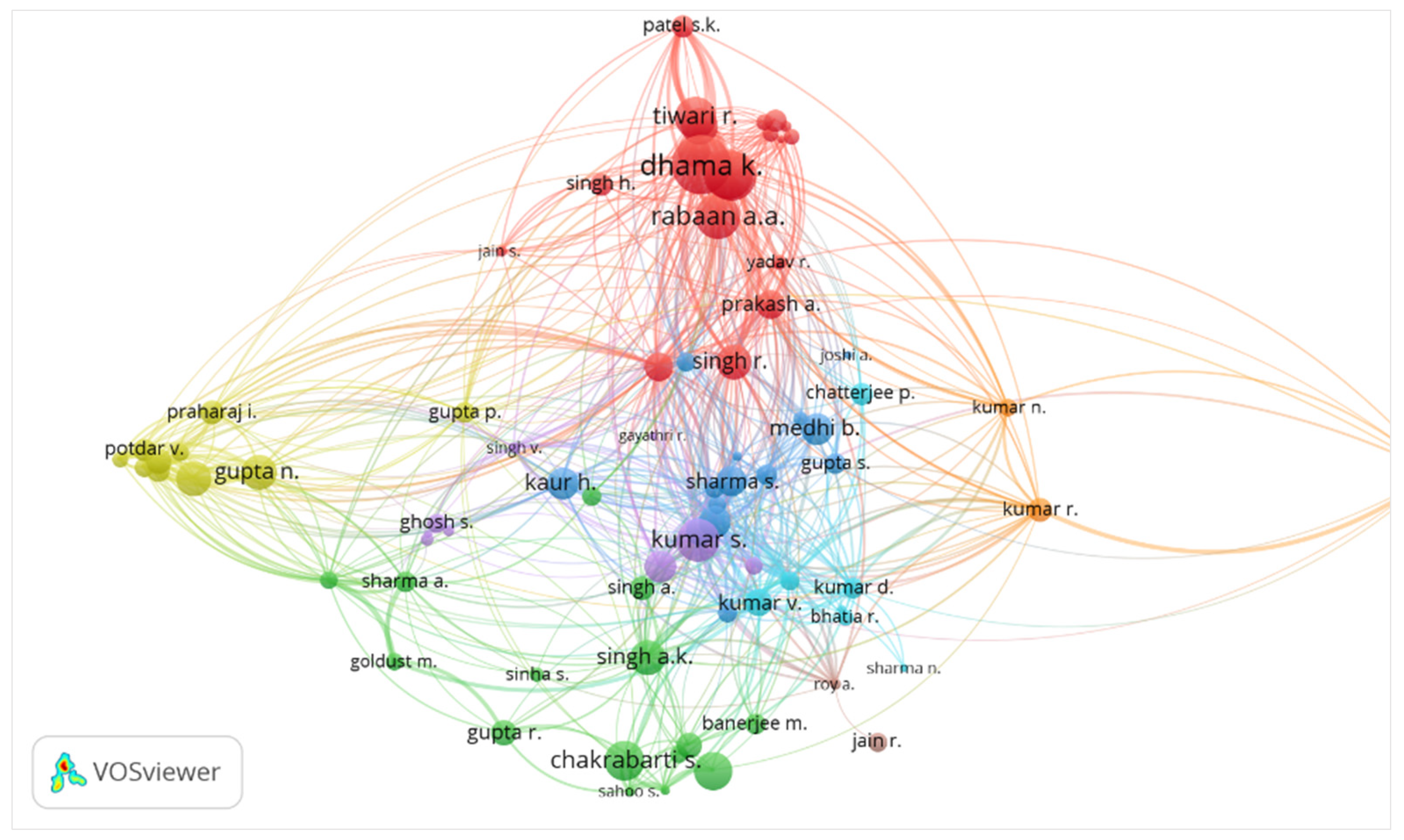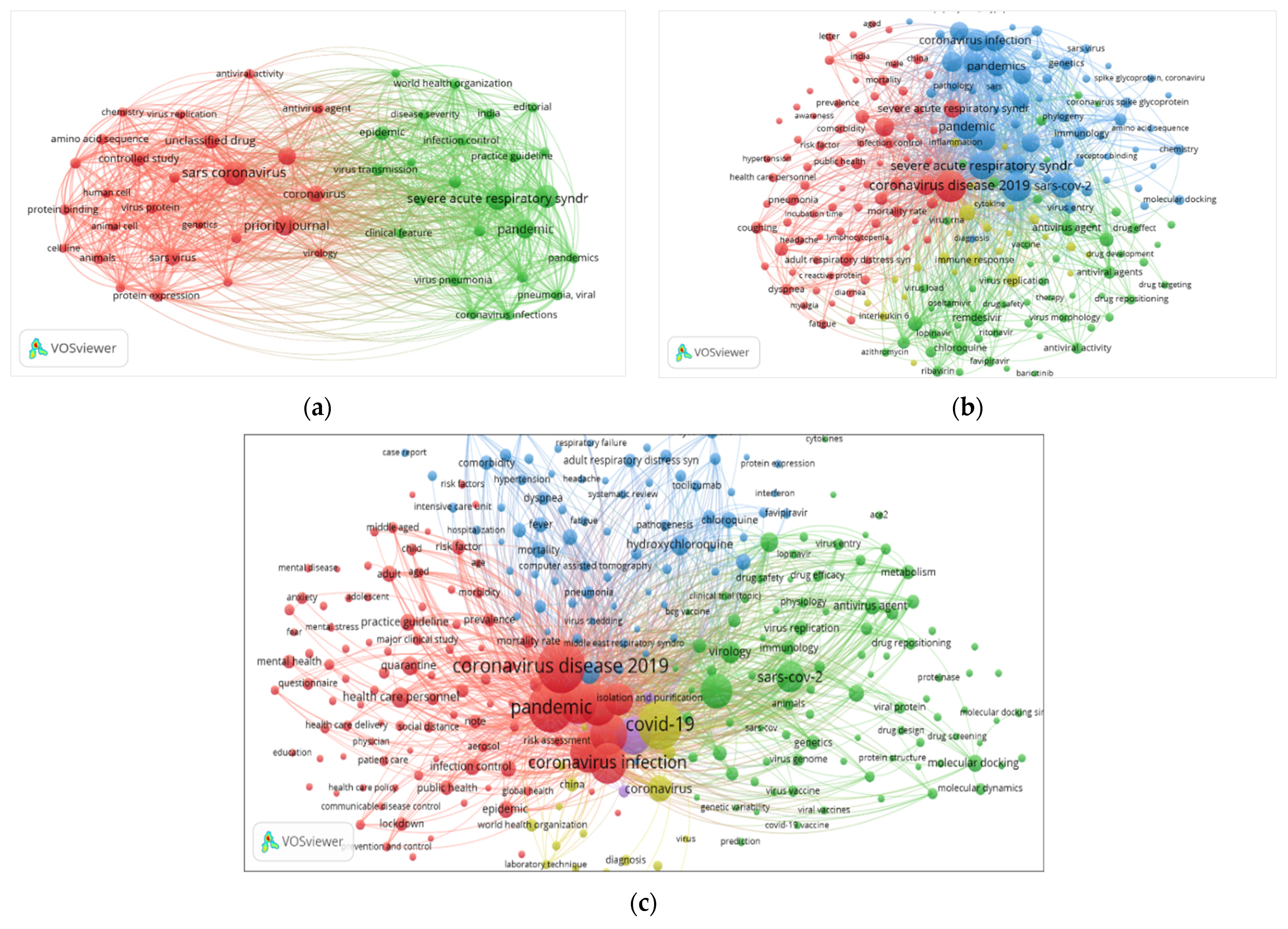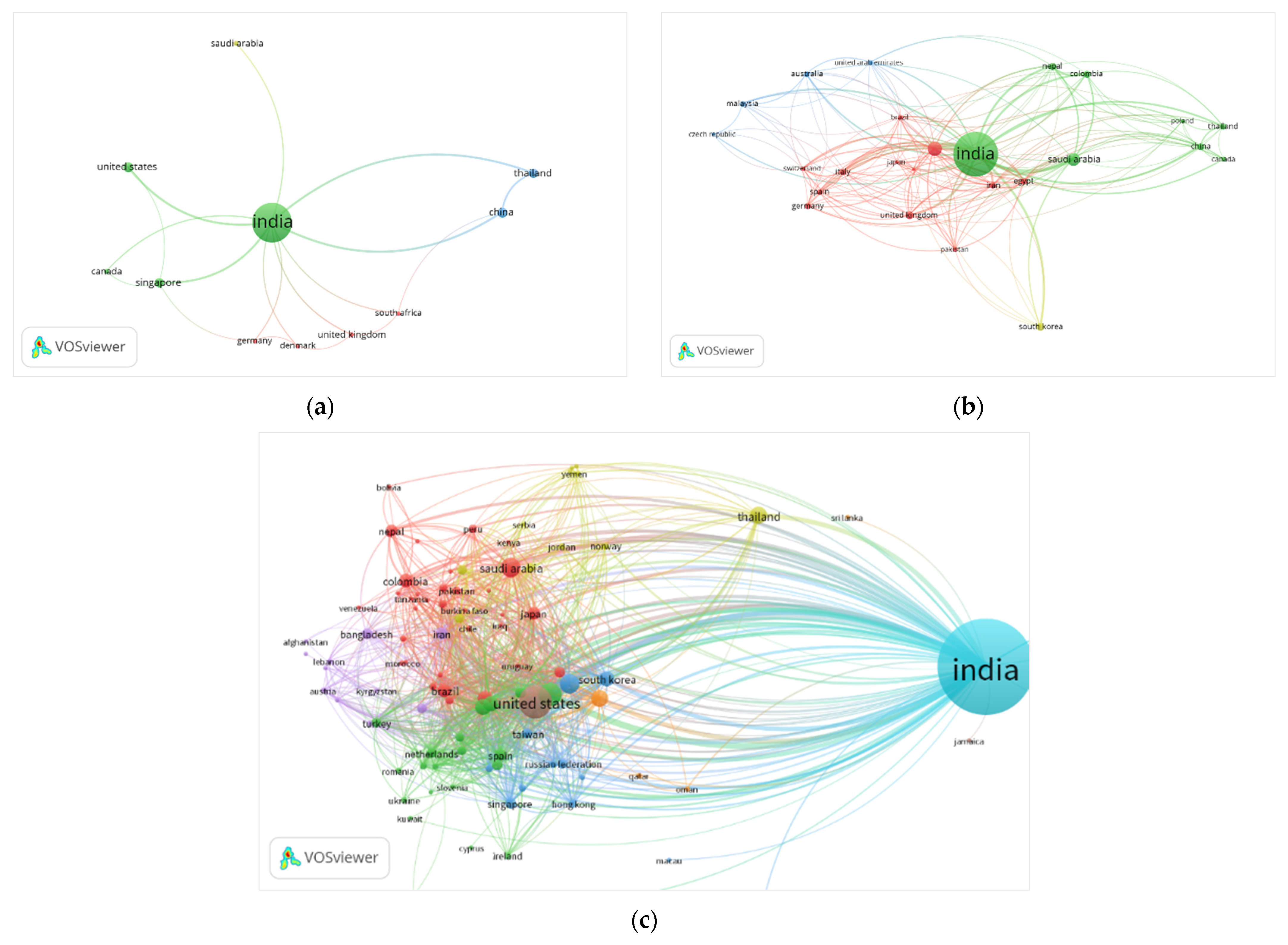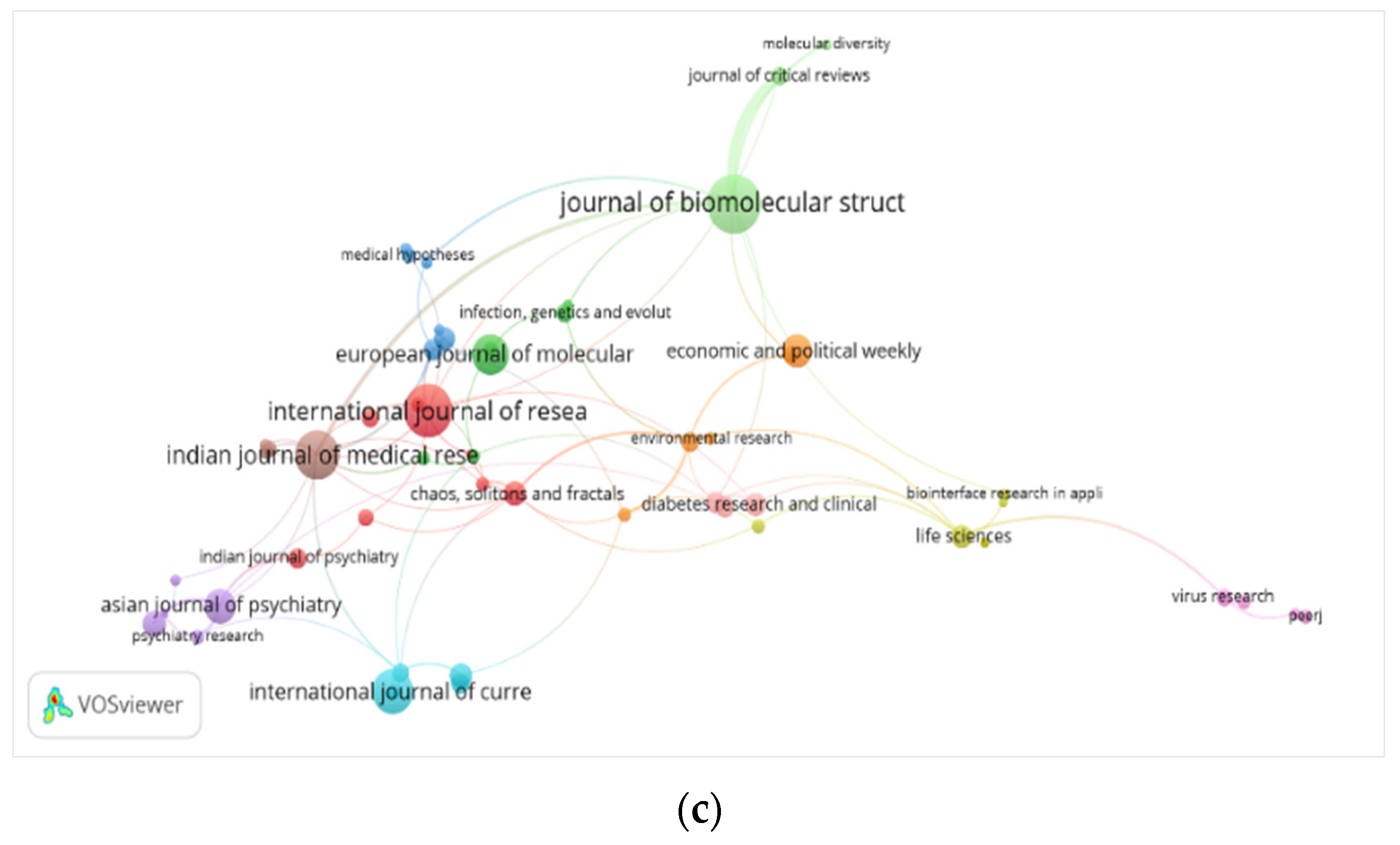1. Introduction
The present COVID-19 pandemic has affected every socioeconomic sector. Globally, everything from manufacturing to entertainment has been affected. Academia is no exception. In fact, most universities globally have suspended on-campus activities and have moved online [
1]. While teaching practices can to some extent be mitigated by digital interventions and online teaching, research is more complex and often requires campus collaboration and laboratory facilities [
2]. While safety norms may require research to be suspended, research is also an essential first step in understanding and fighting this pandemic. Given that it is a novel virus, research regarding its characteristics is integral to developing mechanisms for fighting it. Similarly, methods of detection, isolation, protection, etc., also need to be developed at a fundamental level. In addition, given the scale of the pandemic, research on its effects on other aspects ranging from the global supply chain to mental health needs to be understood and any adverse effects mitigated [
3,
4]. In light of all these needs, researchers across the world have continued their work even under these challenging conditions, generating an impressive volume of research during this time [
5]. In fact, during the early stages of the COVID-19 pandemic, researchers produced a significant number of publications, and the number started growing exponentially, doubling every two weeks by April 2020 [
6]. Furthermore, as of early June 2021, over 167,000 papers on COVID-19 studies have been published despite the restrictions imposed by university closures, social-distancing norms, and disruptions caused by lockdowns [
7]. Much of the information pertaining to the virus and the pandemic has also been made available in the public domain by the leading research institutions in the world.
Two large outbreaks of this coronavirus family had previously been documented with at least one of them receiving the official designation of “global pandemic” [
8]. The first incidence of the Severe Acute Respiratory Syndrome (SARS) disease was recorded on 16 November 2002, in the Guangdong province of Southern China. By 2003, the disease had spread across continents, forcing the World Health Organization to designate it as a pandemic. In fact, SARS is dubbed “the First Pandemic of the Twenty-First Century” [
9]. On 13 June 2012, the first instance of the Middle Eastern Respiratory Syndrome (MERS) was detected in Jeddah. Until COVID-19 came along, these were the two most significant coronavirus epidemics. Each of these prior epidemics, like COVID-19, had their own literature [
10], although on a much lesser scale.
There has been a massive global push for open data sharing during the pandemic. For example, in January 2020, 117 research-related organizations agreed on an open-access data-sharing policy, making any research available to any researcher. The signatories included the likes of Springer and ProMed [
8]. UNESCO prompted over 122 countries to implement an open access policy to combat the pandemic and set up an open-access platform for the same [
9]. The European Union adopted a similar policy by March 2020 [
10]. In order to accelerate the speed of publication, a number of preprint services were set up as well. Though they lack the stringency of a detailed peer review process, such approaches have aided in rapid information sharing [
11,
12]. When compared to other similar infections such as MERS and SARS, COVID-19 has resulted in a mass mobilization of scientific effort, with over 12,000 papers being generated in under five months. The volume of work available at present on this virus alone is greater than the number of publications generated on all coronaviruses over the last two decades [
13]. Clearly, the research community has pulled its weight when it comes to achieving a deeper understanding regarding this virus and pandemic and effectively making the information available to the scientific community.
This is despite the limitations imposed by lockdowns across the world. Lockdowns and other preventive measures such as social distancing have varied in intensity from country to country. In fact, the Oxford COVID-19 Government Response Tracker (OxCGRT) [
14] defines the Oxford Stringency index, which assesses the severity of lockdown restrictions. Countries such as India, Russia, and Mexico had the most stringent lockdowns globally, with India being the most populous country to impose an extremely strict lockdown (Blavatnik School of Government, n.d.). Other countries such as China, Greenland, and many European countries had a more relaxed lockdown in comparison (Blavatnik School of Government, n.d.). Meanwhile, countries such as Sweden and Japan continued to remain relatively open while adhering to social-distancing norms. For comparison, lockdown in India involved the complete suspension of rail, air, and road transport between various states and territories. Furthermore, schools, colleges, and public institutions were completely shut down and people were instructed to stay indoors except for accessing essential services [
15]. Public institutions, transport, and educational institutions remained open in Japan with limited restrictions, while Sweden did not impose any major restrictions.
Most of Europe had less stringent policies than India as well [
16]. All these approaches had varying degrees of success. Even within India, the success of the response varied from state to state, some faring better than others [
17]. However, the overall death rates and per-capita deaths in India have been lower than those of most countries. As of 31 May 2021, India’s death per million people since the beginning of this pandemic is 252, while that of the United States is 1841 and that of Germany is 1071 [
18]. The limited restrictions in Sweden, with a lack of lockdowns, have led to 1426 deaths per million, almost twice as much as the rest of the Scandinavian countries combined. While some error in these numbers is possible due to insufficient testing, it is safe to assume that the lockdown has aided in mitigating the adverse effects of COVID-19 to a significant extent in the country. While this lockdown certainly affected educational institutions from schools to higher research centers, it is interesting to note that India has contributed significantly to research regarding the pandemic. In fact, despite the stringent lockdown and continued travel restrictions, India ranks fifth in a number of publications related to COVID-19 worldwide.
This study focuses on academic literature on COVID-19 globally, and the performance of the Indian Scientific community in comparison to its counterparts. The study compares how India’s overall scientific output in the year 2020, and research specific to COVID-19 for the same period can be valued relative to global output. This is done by comparing several parameters such as publications, citations, international collaborations, journal sources, funding, etc.
According to Oxford COVID-19 Government Response Tracker (OxCGRT), India had one of the strictest lockdowns during the year 2020. The average monthly stringency score (77.9) was the highest for India for more than nine months in the year 2020. There was complete closure of educational institutions with researchers having very limited access to labs to perform experiments. The mood of the nation was also somber with spiraling cases and deaths.
Yet, against this backdrop, authors from India showed phenomenal resilience and conducted research about COVID-19 with whatever forms of data and funding were available. While we are ranked No. 2 in the world for COVID-19 cases, it is very heartening to observe that we are ranked No. 5 in the world for COVID-19 studies. It is this aspect that prompted us to analyze the scientific contribution of researchers from India. Our choice to use bibliometric methods was guided by the fact that we had to examine a large number of publications. Additionally, using Bibliometrics techniques we were able to analyze publications at author, article, journal, country level and compare with worldwide data. Something unique about our study, probably the first one to be completed at the country level, was the comparison of three major epidemics—SARS, MERS, and COVID-19—which draws interesting parallels by using bibliographic couplings and co-citation analysis. Finally, connecting the COVID-19 studies with UN Sustainable Development Goals (SDG) brings in the much-needed relevance of the research.
We have structured the paper as follows:
Section 2 discusses the study methodology using bibliometrics including the search strategy.
Section 3 presents the results and discussion in terms of publications, citations, institutions, and countries including the network analysis with a visual representation of bibliographic data and how COVID-19 studies are connected to sustainable development. Finally,
Section 4 is about the conclusions of the study with limitations and future directions.
2. Study Methods
We followed a two-step process to cover our study objectives. In the first step, we performed the scoping review using the Arksey and O’Malley framework [
19]. A scoping review is a research methodology effective for summarizing and covering broad research topics, comprising a high number of previous studies, publications, methods, theories, or evidence [
20]. Most importantly, a scoping review can pinpoint research gaps without losing research robustness and rigorous quality assessments [
21]. In this step, we proposed research questions; identified the data source and software mapping tools; proposed search strategies; retrieved data from the database. Then in the second step, we performed a bibliometric analysis of the data from scoping review.
Past research performance can be analyzed using qualitative and quantitative methods like literature reviews and meta-research when the quantity of publications and corresponding citations are small. Thanks to social media platforms, researchers are investigating alternative metrics, or Altmetrics, for a more comprehensive perspective of research impact beyond the traditional indicators like publications, citations, etc. [
22]. Sourced from the web, Altmetrics estimate research impact through mentions on Twitter, Mendeley, Online mentions in blogs, etc. However, Altmetrics also has its own limitations: a publication can have high attention because readers are disputing its findings; researchers who are very active on social media with a large following might have higher attention compared to those who are not active on social media.
It is more appropriate and relatively easy to use bibliometric methods to examine a large number of publications which is the case with our study analyzing over 93,000 publications. Bibliometrics is a set of methods to measure scholarly impact from research publications and can easily be scaled from micro (author, article, journal) to macro (subject area, country, world) level. Additionally, with bibliometric science mapping techniques, one can examine how different research themes, author and journal-level publications and citations, institutions, and countries are linked to one another and visualize the results spatially.
Bibliometrics tools have been used in a variety of analyses [
23,
24], including those of authors, journal sources, and citation trends [
25,
26] or country [
27,
28,
29,
30,
31]. Many journals have published bibliometric studies on pandemics such as SARS, MERS, and COVID-19 [
13,
32,
33,
34,
35,
36].
Analyzing Indian publications on SARS-CoV-2 as found in the WHO COVID-19 database [
37], results showed a considerable increase in the number of publications from Indian authors on the topic as compared to SARS and MERS. Most of the authors came from government medical institutions, probably an indication of early access to COVID-19 related data. The WHO COVID-19 database included only curated publications and did not include preprint servers. The bibliometrics study [
38] mainly focused on the growing contribution of the Arab world to global research on COVID-19 with a focus on Saudi Arabia which had the highest number of publications. A total of 143,975 publications reflecting the global overall COVID-19 research output, between December 2019 and March 2021 were retrieved from the Scopus database. The main research themes identified by the study were related to public health and epidemiology; immunological and pharmaceutical research; clinical diagnosis and virus detection. Another bibliometrics study [
39] analyzed publications from Iranian researchers and reported that though most of the studies were related to epidemiology and public health, more collaboration with international researchers is needed.
Two other studies [
40,
41] compared the research work on SARS, MERS, and COVID-19 using both proprietary database and preprint servers like bioRxiv and medRxiv. Using Natural Language Processing techniques, very early COVID-19 data was collected from multiple sources. Analyzing a total of 13,945 publications and seven datasets, the study reported that the quality of research as indicated by citations were substantially higher for COVID-19 studies. COVID-19 bibliometric study [
42] focusing on Latin America, used the Scientific Electronic Library Online (SciELO) database to identify authors, publications, and journals. They reported that since many of the publications were in the Spanish language, they were not adequately represented in international journals. However, the findings of this study further support the assertion that the contents of bibliometric databases have developed a definitive bias toward the English language [
43].
2.1. Research Questions
What are the publication and citation trends of COVID-19-related articles from India and how does it compare with the rest of the world?
Did authors focus on a certain type of publications like journal articles, letters, reviews, etc.?
What major subject areas are pursued by most productive Indian institutions and how does it relate to the subject areas pursued in most productive world institutions?
Which are the influential journals publishing COVID-19 related research?
Did Indian authors have a preference for Open -Access journals and how does such preference compare globally?
Did government or private agencies take the lead in funding COVID-19 studies in India and is this pattern like a global situation?
How does COVID-19 compare with major epidemics like SARS, MERS, and COVID-19?
Are there connections between COVID-19 studies and Sustainable Development as measured by UN SDG?
2.2. Data Sources and Selection of Bibliometric Software Mapping Tools
For our bibliometric analysis, we chose Scopus, which is a large abstract and citation database with over 74 million records from 23,500 peer-reviewed publications in the fields of science, technology, medicine, social sciences, and arts and humanities [
43,
44]. The VOSviewer [
45] software was used to analyze the co-occurrence network for keywords, co-authorship network [
46], citations [
47], and bibliographic coupling [
48]. The h-index [
49] which is widely used in bibliometric studies [
50] was also analyzed.
In our study, we also considered data sources,
https://www.worldometers.info/coronavirus (accessed on 1 January 2021) for data on COVID-19 deaths and cases, as well as
www.scimagojr.com (accessed on 1 January 2021) for Scimago Journal Rankings (SJR). The average of the daily score of the Oxford Stringency index was taken from (
https://COVIDtracker.bsg.ox.ac.uk/, accessed on 1 January 2021) for the period as of 31 December 2020 with a minimum threshold of a daily score of 30 was set to account for varying dates of lockdown measures.
2.3. Search Strategy
Publications were retrieved via a topic search (title/abstract/keywords) from the Scopus database for the year 2020 as of 1 January 2021. The following search queries were created with the goal of reducing the amount of data overlap across the SARS, MERS, and COVID-19 datasets [
40]. In order to eliminate overlap, relevant phrases from various literature were joined with the Boolean operator “AND NOT” in each search. The time period for each search was determined by considering the year in which each virus epidemic occurred.
SARS: (TITLE-ABS-KEY (((“Severe acute respiratory syndrome” OR “SARS”) AND (coronavirus*)) OR (“SARS virus” OR “SARS disease” OR “Severe acute respiratory syndrome disease” OR “Severe acute respiratory syndrome virus” OR “SARS-Cov”)) AND NOT TITLE-ABS-KEY ((“COVID” OR “nCov” OR “COVID-19” OR “COVID19” OR “SARS-Cov-2” OR “Severe acute respiratory syndrome-2” OR “MERS” OR “middle east respiratory syndrome”))) AND PUBYEAR > 2001.
MERS: (TITLE-ABS-KEY (((“Middle east respiratory syndrome” OR “MERS”) AND (coronavirus)) OR (“MERS-Cov” OR “MERS virus” OR “MERS disease” OR “Middle east respiratory syndrome virus” OR “Middle east respiratory syndrome disease”)) AND NOT TITLE-ABS-KEY ((“nCov” OR “COVID-19” OR “COVID19” OR “SARS-Cov” OR “SARS-Cov-2” OR “SARS” OR “Severe acute respiratory syndrome”))) AND PUBYEAR > 2011.
COVID-19: TITLE-ABS-KEY (“COVID-19” OR “COVID19” OR “coronavirus disease 2019” OR “2019-nCov” OR “Novel Coronavirus” OR “Novel Corona virus” OR “SARS-Cov-2”) AND PUBYEAR > 2018.
4. Conclusions
In the present study, the authors performed a bibliometric analysis on COVID-19 publications in India and at multiple places compared to the worldwide data. The United States is the country with the highest number of COVID-19 publications in the year 2020. This might reflect the fact that journal databases and the referencing system usually refer to US standards. Many journals, with a wide range of impact factors, exhibit publications by Indian authors. The publications are the result of collaboration both within India and on the international scene. Our results indicate that the studies on COVID-19 are published by institutions worldwide as also reported by [
63], who studied bibliometric features on the COVID-19 globally. There are many publications in India, which had a rapidly increasing rate of publication after disease emerged in the country, in a pattern similar to that reported by [
64]. This study also shows that there are many publications from both governmental and non-governmental institutes. A worldwide collaboration network can be clearly identified, and this agrees with the report by [
65]. Collaboration is an excellent way to increase the visibility of the work and the generalization of the knowledge. During the early stage of disease emergence, studies in the form of short reports or viewpoints were common and become publications with high numbers of citations [
66]. Such collaboration and active data-sharing policies are essential aspects to fight this pandemic and other future crises [
67,
68,
69]. The high number of studies on COVID-19 indicates that it will be necessary to conduct active research with the emergence of new variants of the diseases [
70,
71,
72].
We also identified important connections between COVID-19 studies at the 17 SDGs of the UN. In particular, there are clear implications on SDGs 3 (on health), 11 (on sustainable cities), and 13 (on climate action), the two latter due to the reduced emissions following the COVID-19 restrictions. Digital contact tracing must be conducted in a decentralized way in order to avoid negative effects on SDGs 10 (on reduced inequalities) and 16 (on strong institutions). Despite the obvious negative effects of COVID-19 on SDGs 8 (on economic growth) and 4 (on quality education), we would like to highlight the very important consequences of SDGs 1 (on no poverty) and 5 (on gender equality), which are not as prominently represented in the literature.
A detailed assessment of the scientific work published in reaction to the three most notable coronavirus outbreaks, namely SARS, MERS, and COVID-19, reveals striking parallelisms. Public-health and emergency-management studies are the first to appear, followed by virology studies. The volume and rate of scholarly study on COVID-19, on the other hand, remains an outlier, potentially unparalleled in the history of scientific literature.
Although India had a reasonably large number of reported COVID-19 cases, the number of publications at the time of the study still follow countries where the disease occurred earlier. However, in recent weeks, the situation has abruptly changed for the worse with India reporting a very high number of daily cases mainly attributed to the double-mutant strain. Many states have again implemented lockdowns resulting in the closure of campuses. It remains to be seen how the academic community will adapt to this new situation.
In comparison to earlier epidemic outbreaks, the publication of COVID-19 research is moving at a torrid pace. As of 23 June 2021, over 195,568 COVID-19 studies have been published in Scopus. Additionally, there are several tens and thousands in the preprint servers which are not yet peer reviewed. A similar pace is seen with Indian authors who have already published 5403 articles in the first five months of 2021, compared to 6423 articles for all of 2020. It is very possible that bibliometrics as a field is not equipped to explain such steep trajectories of publications and citations in such a short time since bibliometricians work on substantially longer timescales [
28,
36]. Secondly, unlike the boxed search phrases above, the description of an emerging research area is rarely as clear and understandable.
